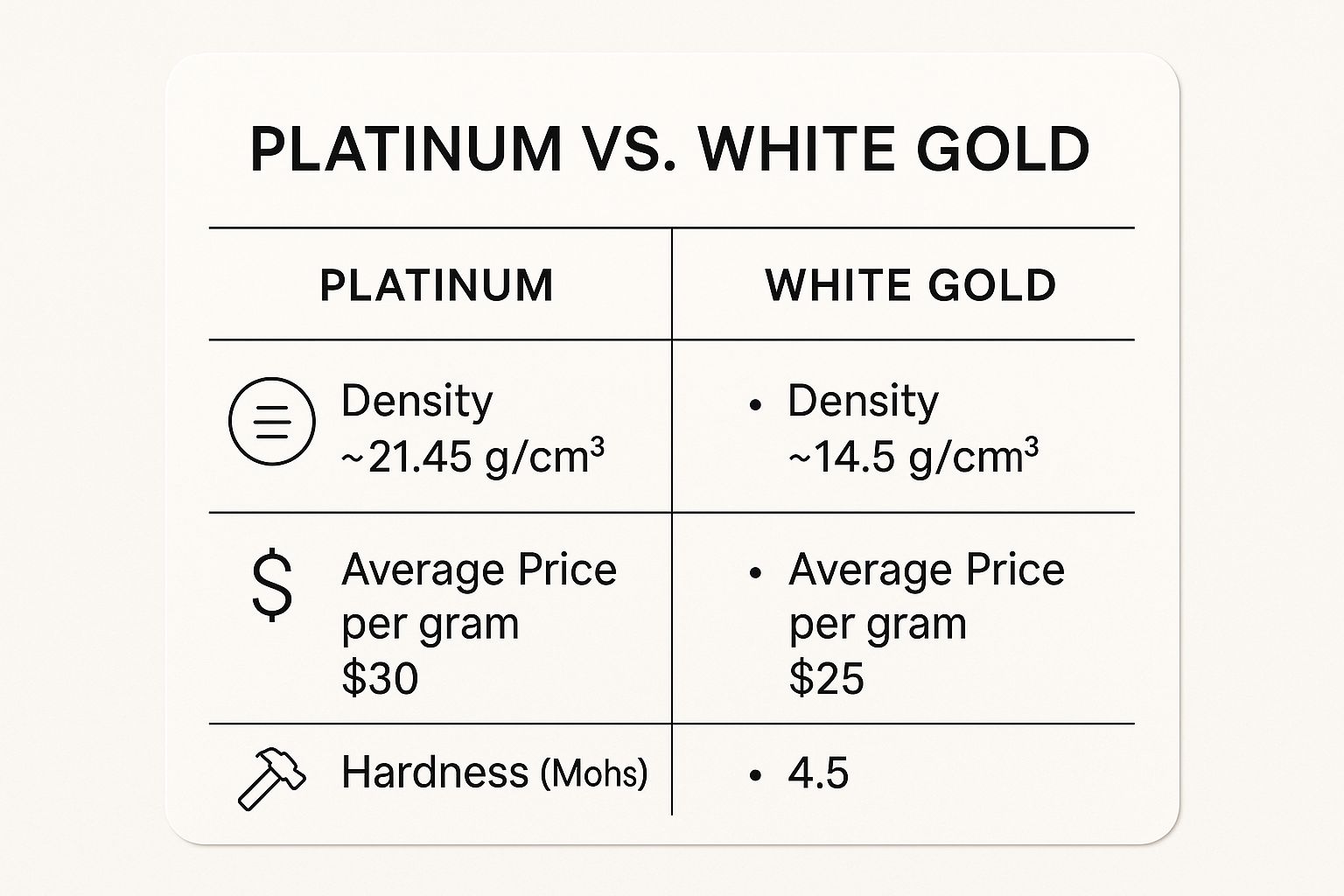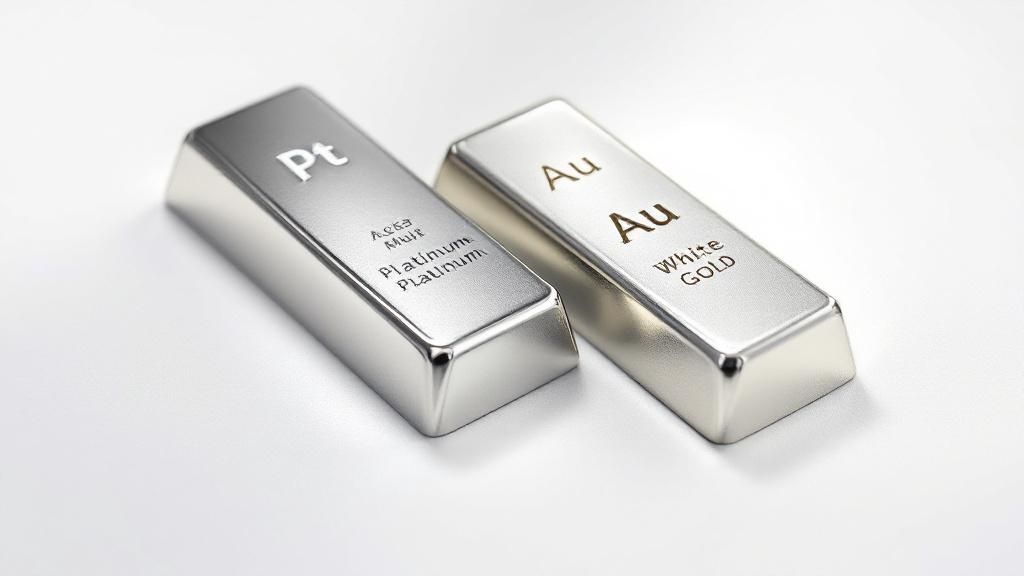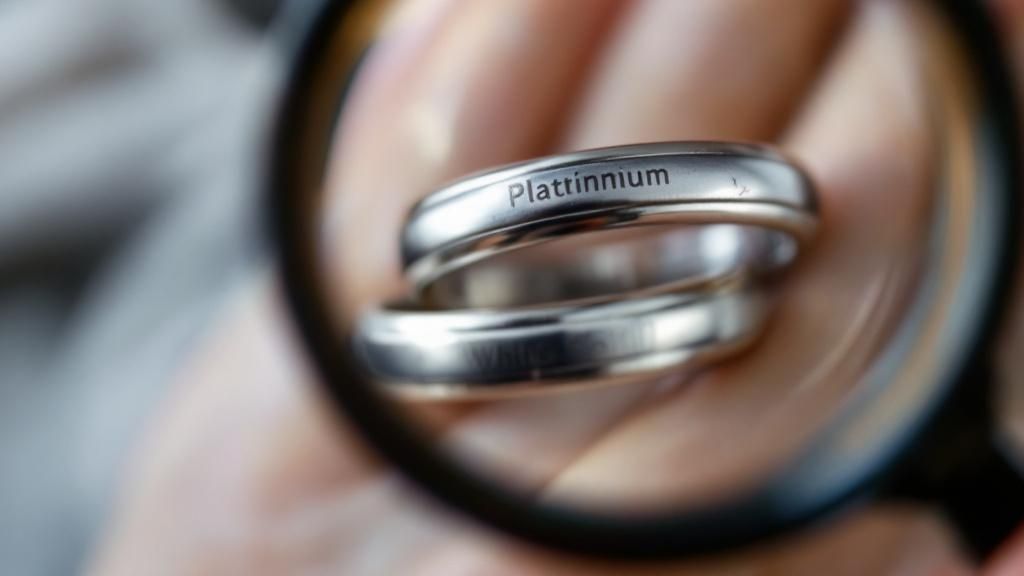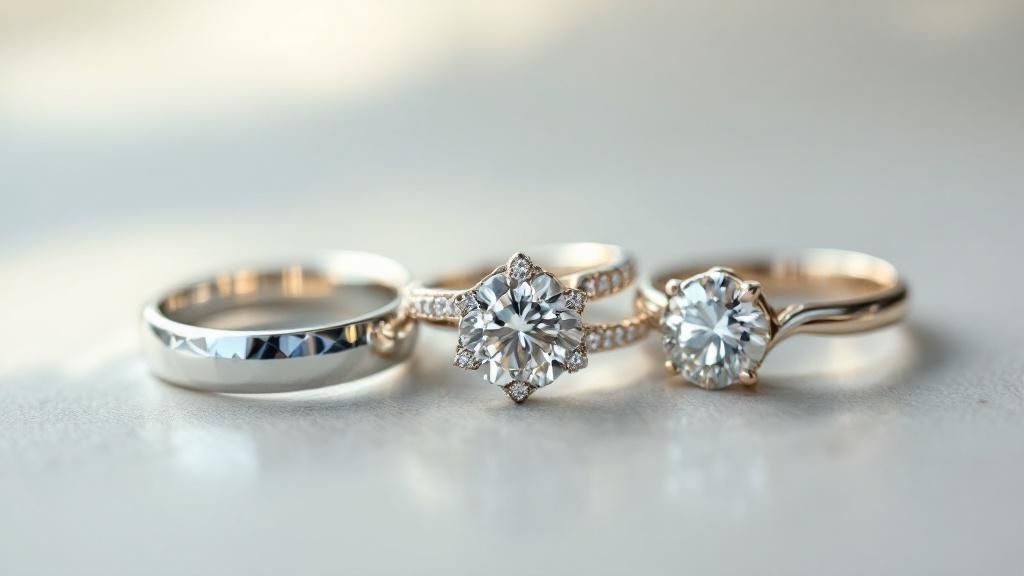Platinum vs White Gold A Definitive Guide
- alex mark
- Jul 7
- 13 min read
When you boil it down, the choice between platinum and white gold comes down to a simple trade-off. Platinum is a *naturally white, dense, and hypoallergenic metal*, while white gold is a *gold alloy that gets its color from a rhodium plating*. The right decision really depends on what you value more: platinum's inherent durability and purity, or white gold's lower upfront cost, which comes with some long-term maintenance.
Understanding the Fundamental Differences
Choosing between these two brilliant white metals isn't just about aesthetics; it's about deciding between something naturally occurring and something expertly crafted. Both offer a stunning, contemporary look compared to traditional yellow gold, but they get there in very different ways. Getting to know these core distinctions is the key to choosing a ring you'll love for years to come.
To really get a feel for what sets them apart, let's look at a few key areas:
Composition and Purity: Platinum is a naturally white metal. The jewelry you see is typically 95% pure (stamped 950), with the remaining 5% being other similar metals. White gold, on the other hand, is an alloy made by mixing pure yellow gold with white metals like palladium or nickel, and then it's almost always plated with rhodium for that crisp, bright white finish.
Durability and Wear: Both metals are quite strong, but they show wear in completely different ways. Platinum is much denser, so when it gets scratched, the metal simply gets displaced, developing a unique, soft finish called a patina. Scratches on white gold, however, can wear away the rhodium plating, revealing the slightly yellowish gold alloy underneath.
Cost and Value: Platinum is rarer and denser, so it will almost always cost more upfront. But don't forget the long game—white gold needs to be re-plated every so often, which is a recurring maintenance cost you'll want to factor in.
Hypoallergenic Properties: Because it's so pure, platinum is naturally hypoallergenic, making it a fantastic choice for anyone with sensitive skin. Some white gold alloys, especially those containing nickel, can cause allergic reactions for some people.
This infographic gives a great visual summary of the key differences at a glance.

You can see from the data just how much denser and harder platinum is, which is a big reason for its durability and premium feel on the hand.
At a Glance Platinum vs White Gold
Sometimes you just need a quick rundown. This table breaks down the core differences to help you see which metal’s qualities are the best fit for you.
Attribute | Platinum | White Gold |
|---|---|---|
Color | Naturally grayish-white | Bright, silvery-white (from rhodium plating) |
Composition | 95% pure platinum | 58.3% (14k) or 75% (18k) gold + alloys |
Durability | Scratches create a patina; metal is displaced | Scratches can remove plating and metal |
Maintenance | Optional polishing to restore shine | Requires rhodium re-plating every few years |
Hypoallergenic | Yes, naturally hypoallergenic | Can contain nickel, a common allergen |
Initial Cost | Higher | Lower |
Ultimately, both metals are excellent choices, but knowing these details ensures you pick the one that truly aligns with your lifestyle, budget, and personal preference.
Durability and Wear: How They Hold Up Day-to-Day

When you’re deciding between platinum and white gold, how each metal stands up to the demands of everyday life is a huge piece of the puzzle. Both are strong, sure, but they handle scratches and wear in completely different ways. This isn't just a minor detail—it directly affects how your ring will look years from now and the maintenance it will need. A ring is an everyday companion, after all, so you want its resilience to match your lifestyle.
Platinum is a remarkably dense metal. When it gets scratched, none of the metal is actually lost. Instead, the material is just pushed around, displaced from one spot on the ring to another. Because of this unique property, platinum doesn't show wear like other metals. Over time, it develops what’s known as a patina—a soft, almost frosted matte finish.
Many people actually love this patina. They see it as a beautiful record of the ring's journey and a sign of its authenticity. But if you're someone who prefers that just-bought, high-shine look, it's no problem. A quick trip to the jeweler for a professional polish will bring back its original luster in a snap.
The White Gold Wear and Tear Story
White gold’s journey is quite different. As an alloy—meaning it’s pure yellow gold mixed with other white metals—its bright, silvery-white color isn’t entirely natural. That shine comes from a very thin, very hard coating of rhodium plating applied to the surface.
So, when a white gold ring gets scratched, two things happen. First, a microscopic bit of the gold alloy itself might be worn away. More importantly, that tough rhodium plating can get scuffed and begin to wear thin.
As this protective layer wears down, the slightly warmer, yellowish tint of the gold alloy underneath can start to peek through. You'll usually notice this first on the parts of the ring that see the most action, like the back of the band.
"One of the most significant differences between platinum and white gold is their durability and maintenance requirements. Platinum is known for being more durable and less prone to wear and tear compared to white gold...This maintenance aspect makes platinum more appealing to consumers who are looking for a long-lasting option without the need for frequent visits to a jeweler."
What This Means for Maintenance
The way these two metals wear dictates very different long-term care routines. It's something you really need to factor into your decision.
For white gold, keeping that brilliant white shine means you’ll need to have it periodically re-plated with rhodium. How often depends entirely on you and your lifestyle.
Active Lifestyles: If you're a hands-on person or wear your ring 24/7, you might be looking at a re-plating trip every 1-2 years.
Less Frequent Wear: If you're careful and take your ring off for manual tasks, you could go 3-5 years or even longer between plating sessions.
This service is standard practice for any reputable jeweler. It's not a huge hassle, but it is a recurring cost and time commitment to keep in mind for the life of the piece. If you're curious about upkeep, take a look at our guide on how to clean gold jewelry for a stunning shine.
On the other hand, platinum is much lower on the mandatory maintenance scale. Because its silvery-white color is natural and runs all the way through the metal, it will never fade or change color. The choice to polish it is purely cosmetic—it all comes down to whether you prefer the developing patina or a high-shine finish. For many, this makes platinum the ultimate "set it and forget it" choice.
Analyzing the True Cost and Long-Term Value

When you’re standing at the jewelry counter, the first thing you'll notice is the price difference. Platinum almost always costs more upfront than white gold, and it's not just about brand names or style—it comes down to the fundamental nature of the metals themselves.
The biggest reason for the price gap is density. Platinum is incredibly dense, about 60% denser than 14k gold. This means a ring of the exact same size and shape requires significantly more platinum by weight. That fact, coupled with platinum's natural rarity, pushes its base price higher. Plus, it takes specialized tools and a higher level of craftsmanship to work with platinum, which adds to the final labor cost.
Beyond the Showroom Price
The sticker price is only the beginning of the story. To understand the real cost, you have to think about the total cost of ownership over a lifetime. This is where the financial decision gets a little more interesting.
White gold might be friendlier to your wallet initially, but it comes with a predictable maintenance schedule. To keep that crisp, bright-white shine, white gold needs to be re-plated with rhodium every couple of years. Each session can cost anywhere from $60 to $120. Over the decades you'll own the ring, those appointments can really add up, slowly closing the initial price gap with platinum.
Platinum, on the other hand, is what I call a "set-it-and-forget-it" metal. It doesn't need any mandatory upkeep to maintain its natural color. Any polishing to remove the patina it develops is completely optional and a matter of taste, making its long-term cost much more predictable.
Investment and Resale Value
Thinking of your ring as an asset? That adds another important dimension. Platinum jewelry is usually 95% pure, which means it holds its value exceptionally well over time. Its prestige and rarity give it a distinct edge in the resale market compared to gold alloys.
White gold, by definition, is a mix of pure gold and other metals, so its inherent purity is lower. It absolutely retains value, but it just doesn't carry the same investment-grade weight as platinum. This is something to keep in mind if the long-term financial aspect of your jewelry is a major factor. Making the right choice from the start is key, and you can get more guidance with our [8 essential jewelry buying tips for 2025](https://www.pantherdeluxe.com/post/8-essential-jewelry-buying-tips-for-2025).
Typically, you can expect platinum to be 40-50% more expensive than white gold. That premium reflects its rarity and the sheer amount of metal needed to make a piece. However, as gold prices fluctuate and sometimes surge, this price gap can shrink, making platinum an even more attractive option for those looking for lasting value. You can find more data on the platinum jewelry market on platinuminvestment.com.pdf).
Color, Composition, and Skin Sensitivity
When you start comparing platinum and white gold, you quickly realize their differences go far deeper than just their appearance. Their fundamental makeup is what sets them apart, and that chemical distinction has a major impact on their color, how they feel on your hand, and even how your skin reacts to them. Getting a handle on these core properties is the first step toward choosing a ring you’ll love for a lifetime.
What Is White Gold, Really?
White gold doesn't come out of the ground looking like that. It's an alloy, which means pure yellow gold is mixed with other white metals to bleach its natural yellow color. The most common metals used in this blend are palladium, silver, and nickel. Once the gold is mixed, the piece is usually given a final coating of rhodium, a brilliant and hard metal from the platinum family, to give it that stunning, mirror-like shine.
The amount of pure gold in the mix determines its karat value. You'll typically see two common options:
14k White Gold: This is 58.3% pure gold mixed with 41.7% other metals. It’s a fantastic middle ground, offering a solid blend of durability and value.
18k White Gold: At 75% pure gold and 25% other metals, this alloy is softer and has a higher intrinsic gold value. Its underlying color is often a bit warmer.
Without that rhodium plating, white gold often has a faint, warm off-white or even a pale grayish-yellow tone. That outer coating is what delivers the crisp, silvery-white look people expect.
Platinum: Pure, Strong, and Naturally White
Platinum is a whole different story. It’s a naturally white metal, so it doesn't need any plating or special mixing to get its color. The platinum used for fine jewelry is incredibly pure, typically 95% pure platinum (you'll see it stamped "950 Plat" or "PLAT"). The remaining 5% is usually another platinum-group metal like iridium or ruthenium, added just to make it a bit harder for jewelry-making.
This high purity means platinum's cool, silvery-white hue is consistent all the way through. It's not a coating; it's the metal itself. While rhodium-plated white gold has a bright, almost chrome-like flash, platinum possesses a deeper, richer luster that's all its own.
For many people, especially those with sensitive skin, this is the most important takeaway: platinum is naturally hypoallergenic. Its purity means it’s free of common allergens that can cause skin irritation.
A Quick Word on Allergies
This brings us to one of the most critical factors in the platinum vs. white gold decision: skin reactions. A lot of white gold alloys, especially the more budget-friendly ones, use nickel in the mix. Nickel is one of the most common skin allergens out there. For many people, wearing a ring with nickel can trigger contact dermatitis, resulting in uncomfortable redness, itching, and rashes.
While you can find white gold made with hypoallergenic palladium alloys, it’s not the default and often comes at a higher price. If you have sensitive skin or have ever reacted to jewelry before, platinum is hands-down the safest bet. Its natural purity ensures it won't cause trouble, giving you the peace of mind to wear your ring every single day without worry.
How History And Trends Shape Your Choice
Choosing between platinum and white gold isn't just about comparing their physical traits. It’s a decision steeped in over a century of history, culture, and fluctuating market forces. Both metals have a rich backstory that shapes how we see them today, from symbols of royal power to accessible modern luxury. Digging into this context adds a compelling layer to your choice, connecting your personal taste to a much larger story of style and value.
White gold first appeared in the early 20th century, created as a brilliant and affordable substitute for platinum. A German jeweler named Karl Richter patented the alloy in 1912, and it quickly caught on. Its beautiful silvery-white sheen and friendlier price point finally made the coveted "white metal look" available to a wider audience, securing its place as a jewelry staple.
Platinum's Enduring Legacy
Platinum, on the other hand, has always held a special status of ultimate prestige. Its extreme rarity and naturally bright white luster made it the go-to metal for royalty and the ultra-wealthy long before white gold was even a thought. This deep-rooted historical connection gives platinum a built-in sense of exclusivity and timeless worth that still speaks to buyers who want the absolute best.
Current Market Trends and Future Outlook
Today, the relationship between these two metals is changing again, largely due to shifts in global commodity prices. As the price of gold has climbed, the cost difference between white gold and platinum has started to shrink dramatically. This is making both shoppers and jewelers rethink the value of each metal. The evolving market is a critical factor to watch, and you can see its influence on other popular pieces by checking out current [gold bangle trends](https://www.pantherdeluxe.com/post/gold-bangle-trends).
This closing price gap is setting the stage for a fascinating potential shift in the jewelry world. For decades, platinum was the undisputed premium choice with a price tag to match, but it's now becoming a much more competitive option.
For instance, if platinum jewelry were to capture just a 5% share of the white gold market, it could dramatically impact platinum market dynamics, signaling a major change in consumer preference. You can learn more about [the history of these metals on jewelersmutual.com](https://www.jewelersmutual.com/the-jewelry-box/platinum-vs-white-gold).
This trend positions platinum not just as a metal of historical significance but also as a smart, forward-thinking investment for today's buyer. As more people recognize its superior durability and hypoallergenic properties at a newly competitive price, platinum's market share is poised to grow, potentially redefining it as the new standard for high-quality white metal jewelry.
Making the Right Decision for You

Choosing between platinum and white gold isn't about which metal is technically "better"—it's about which one is better for you. It really comes down to how you live, what you're comfortable spending, and what you value most in a piece of fine jewelry.
Let's move past the specs and look at a few real-world situations. Thinking through these scenarios will help you see which metal aligns with what matters to you.
For the Active and Hands-On Person
Do you work with your hands, live an active life, or just never take your rings off? If you’re a doctor, an artist, a parent, or a fitness enthusiast, you need a ring that can keep up. This is where platinum truly shines.
Platinum is incredibly dense. When it gets scratched or knocked, the metal just moves aside—it doesn’t actually get worn away. This means it develops a unique, soft finish, called a patina, over the years without losing any of its substance. You get all the durability without worrying about a plating layer wearing thin.
For someone who prioritizes low-maintenance durability above all else, platinum is the ideal choice. It's built to withstand the rigors of daily life without needing cosmetic upkeep to maintain its color or strength.
For the Budget-Conscious Buyer
If your main focus is getting that brilliant, silvery-white look without the premium price tag, 14k white gold is a fantastic choice. It gives you the classic, bright shine you’re looking for at a much more accessible upfront cost compared to platinum.
The only catch is being prepared for a little maintenance down the road. To keep its crisp, white color, it will need to be re-plated with rhodium every couple of years. For a lot of people, this is a perfectly reasonable trade-off for the significant initial savings.
For Sensitive Skin or Long-Term Prestige
There are two situations where platinum is the undisputed winner. First, if you have sensitive skin or a known nickel allergy, platinum’s hypoallergenic nature makes it the safest and most comfortable option, period.
Second, if your decision is driven by a desire for rarity, prestige, and an investment that holds its value, platinum is in a class of its own. Its 95% purity and history as a top-tier precious metal give it an heirloom quality that feels substantial and truly luxurious.
A Few Final Questions
Even after weighing all the pros and cons, you might have a couple of questions still on your mind. Let's tackle some of the most common ones that come up when people are deciding between platinum and white gold. Getting these answers straight can help you make that final choice with complete confidence.
Which Metal Holds a Diamond More Securely?
Both platinum and white gold will hold your diamond securely, so you can feel good about either choice. That said, platinum has a real advantage here because of its unique properties. It's incredibly dense and ductile, which is a fancy way of saying it's strong but can be bent without breaking.
When a jeweler sets a stone with platinum prongs, those prongs are tougher and far less likely to snap or crack than gold ones. Over a lifetime of wear and tear, this gives platinum a slight edge in security. While a well-crafted white gold setting is perfectly safe, platinum’s natural strength offers that extra bit of peace of mind, especially if you have a large diamond or a delicate setting.
Does Platinum Scratch More Easily Than White Gold?
This is where things can get a little confusing, but the distinction is important. Yes, platinum is technically a softer metal than 14k white gold, so it can pick up surface-level scratches more easily. But how each metal scratches is what really matters.
When platinum gets scratched, the metal simply gets moved around on the ring's surface. No metal is lost. Over time, this creates what jewelers call a patina—a soft, lived-in finish that many people love. With white gold, a scratch can wear away its hard rhodium plating, exposing the slightly yellowish gold alloy underneath. Tiny bits of metal can actually be lost.
So, you might notice scuffs on a platinum ring sooner, but the ring itself remains just as strong. White gold's "hardness" really comes from its rhodium coating, which needs re-plating every so often to keep it looking pristine.
Is Platinum Always the Better Choice?
Absolutely not. The best choice is the one that fits your lifestyle and budget. There's no single right answer for everyone.
Platinum is the clear winner if your top priorities are long-term durability, a naturally hypoallergenic metal, and avoiding future maintenance. On the other hand, white gold is a fantastic option if you're looking for that bright white look at a more accessible price point and don't mind the routine upkeep of having it re-plated down the road.
At Panther De Luxe Shop, we believe the perfect ring is simply the one that fits your life. We encourage you to explore our curated collections of both platinum and white gold jewelry to find the piece that truly speaks to you. Discover your forever ring.

Comments